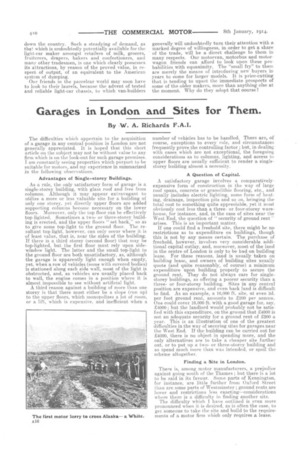Garages in London and Sites for Them.
Page 2

If you've noticed an error in this article please click here to report it so we can fix it.
By W. A. Richards F.A.I.
The difficulties which appertain to the acquisition of a garage in any central position in London are not generally appreciated. It is hoped that this short article on the subject. may not be without. value to any firm which is on the, look-out for such garage premises. I am constantly seeing properties which purport to be suitable for motors, and my experience in summarized in the following observations.
Advantages of Single-storey Buildings.
As a rule, the only satisfactory form of garage is a single-storey building, with glass roof and free from columns. Although it may appear extravagant to utilize a more or less valuable site for a building of only one storey, yet directly upper floors are added supporting columns become necessary on the lower floors. Moreover, only the top floor can be effectively top-lighted. Sometimes a twoor three-storey building is erected, and the upper floors " set back," so as to give some top-light to the ground floor. The resultant top-light, however, can only occur where it is of least value, that is, near the sides of the building. If there is a third storey (second floor) that may be top-lighted, but the first floor must rely upon sidewindow light. The latter and the small top-light to the ground floor are both unsatisfactory, as, although the garage is apparently light enough when empty, yet, when a row of vehicles (some with covered bodies) is stationed along each side wall, most of the light is obstructed, and, as vehicles are usually placed back to wall, the engine comes in a position where it is almost impossible to see without artificial light.
A third reason against a building of more than one storey is that them must either be a slope (run up) to the upper floors, which monopolizes a lot of room, or a lift, which is expensive, and inefficient when a number of vehicles has to be handled. There are, of course, exceptions to every rule, and circumstances frequently prove the controlling factor ; but, in dealing with cases which are not exceptional, the foregoing considerations as to columns, lighting, and access to upper floors are usually sufficient to render a singlestorey building almost a necessity.
A Question of Capital.
A satisfactory garage involves a comparativelyexpensive form of construction in the way of large roof spans, concrete or granolithic flooring, etc., and usually includes electric lighting, some form of heating, drainage, inspection pits and so on, bringing the total cost to something quite appreciable, yet it must obviously cost less than a threeor four-storey warehouse, for instance, and, in the case of sites near the West End, the question of " security of ground rent" arises. This is an important matter.
If one could find a freehold site, there might be no restrictions as to expenditure on buildings, though this is not by any means certain. The purchase of freehold, however, involves very considerable additional capital outlay, and, moreover, most of the land in the centre of London is only to be had on building lease. For these reasons, land is usually taken on building lease, and owners of building sites usually quote (and quite reasonably, of course) a minimum expenditure upon building properly to secure the ground rent. They do not always care for singlestorey buildings, as offering a poorer security than a threeor four-storey building. Sites in any central position are expensive, and even back land is difficult to find. As an example, a 16,000 ft. site, at even 3d. per foot ground rent, amounts to 200 per annum. One could cover 16,000 ft. with a good garage for, say, £4000; but the landlord would probably not be satisfied with this expenditure, on the ground that £4000 is not an adequate security for a ground rent of £200 year. This is an illustration of one of the greatest difficulties in the way of securing sites for garages near the West End. If the building can be carried out for £4000, there is no object in spending more, and the only alternatives are to take a cheaper site further out, or to put up a twoor three-storey building and so spend much more than was intended, or spoil the scheme altogether.
Finding a Site in London.
There is, among motor manufacturers, a prejudice against going south of the Thames ; but there is a lot to be said in its favour. Some parts of Kennington, for instance, are little further from Oxford Street than are some parts of Westminster ; ground rents are lower and restrictions less exacting—considerations where there is a difficulty in finding another site.
The difficulty which I have outlined is even more pronounced when it is desired, as is often the case, to get someone to take the site and build to the requirements of a motor firm which only require's a lease'.




















